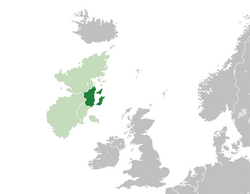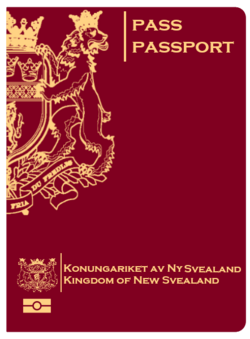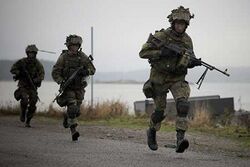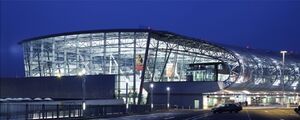New Svealand
Kingdom of New Svealand Konungariket av Ny Svealand | |
|---|---|
| Motto: Du stark, du fria, du fredlig You strong, you free, you peaceful | |
| Anthem: Vårt land | |
 Location of New Svealand (not including overseas territories). | |
| Capital | Rosenburg |
| Largest | Skoganbyen |
| Official languages | English, Swedish |
| Recognised regional languages | Fjeskan |
| Ethnic groups (2014) |
|
| Religion | Church of New Svealand |
| Demonym(s) | Svealandic |
| Government | Unitary parliamentary constitutional monarchy |
• Monarchy | Oskar II |
• Prime Minister | Christoffor Elvestad |
| Legislature | Landstinget |
| Establishment | |
• Treaty of Rosenburg | 29th April 1490 |
• German Occupation | 30th May 1940 |
• Restoration after German Occupation | 27th September 1943 |
| Area | |
• Total | 30,774.6 km2 (11,882.1 sq mi) (139th) |
• Water (%) | 10.7 |
| Population | |
• 2015 estimate | 4.4 million (120th) |
• 2014 census | 4,452,357 |
• Density | 162.3/km2 (420.4/sq mi) (76th) |
| GDP (nominal) | 2015 estimate |
• Total | $204.321 billion (48th) |
• Per capita | $46,436.59 (23rd) |
| Gini | 26.2 low |
| HDI (2015) | very high (23rd) |
| Currency | Svealandic Krona (SKR) |
| Time zone | UTC-1 (NST) |
| Date format | dd-mm-yyyy |
| Driving side | right |
| Calling code | +50 |
| ISO 3166 code | SV |
| Internet TLD | .sv |
New Svealand (Svealandic: Ny Svealand) or Svealand, officially the Kingdom of New Svealand (Svealandic: Konungariket av Ny Svealand) is a Nordic country in northwestern Europe. It is bordered by Seketan to the north, Alquiya to the west, and Lormotia to the south. Found on the east coast of Nelbecia southeast of the Fjoške mountains, it is the second smallest country in the Nelborne at 30,774.60 km² (11,882.14 sq mi). Populated by 4.9 million people, New Svealand has a population density of approximately 162.3/km2/km2 (420.70/sq mi). The country, especially along the Seketese border, is mountainous and heavily forested whereas the south is primarily agricultural. Due to its northerly latitude and the significant maritime influence, New Svealand has a relatively mild climate, despite this cold winters are not uncommon.
Originally inhabited by Secenic cultures, New Svealand was held by numerous other empires until 1490 when the Svealandic kingdom was established under Prince Markus I following the Svealandic War of Independence. During the late medieval period, New Svealand was split between the kingdoms of Scotland and Seketan. Following the end of the Swedish-Seketese War in 1361, Svealand was annexed by the Kingdom of Sweden. Independence was attained in 1490 after the Svealandic War of Independence. New Svealand retained independence despite numerous invasion attempts from other Nelbec powers. The country endured the Nelborne Front of World War I and the Nelborne War before ultimately facing German occupation in World War II for three years. The country was liberated upon allied victory in the Nelborne Front of World War II. After the end of the Cold War, Svealand grew economically due to increased outside investment from countries such as the United States and Canada.
Svealand is a constitutional monarchy and a parliamentary democracy, with the king as head of state. The capital city is Rosenburg with Skoganbyen being the most populous city in the country. power is vested in the 200 member unicamera Riksdagenat. Executive power is exercised by the government chaired by the prime minister. Svealand is a unitary state, currently divided into five territories. As a member of the United Nations, the Nordic Council, the World Trade Organisation and the Organisation for Economic Co-operation and Development (OECD), Svealand boasts a strong economy while maintaining a Nordic style social welfare system. While ranking highly in many metrics of national performance such as in health, education, and human development, Svealand maintains a strong capable armed force
History
Geography
New Svealand is the smallest nation of the four in the Nelborne region. Svealand can be found in the North East of the Nelborne region on the east coast of the island. To the south it shares border with Lormotia and the the West Alquiya and borders Seketan along the Riketskant river to the north.
The two islands to the east of Svealand that make up the Givanord territory are one of the nations most cultural and historic locations. Along with this, the largest mountain in the country: Trofålta reaches a height of 2,469 meters (8,100 feet) is one of the nations biggest tourist hotspots. The nations longest river, the Fjörgynblod covers a distance of 286 miles (460 km) the river also flows into the largest lake in Svealand called Koppasjö.
Flora and fauna
Svealand's wildlife is typical of the Nelborne region, with several of the larger mammals such as the lynx, brown bear, wolf, elk and seals being extremely common. There are important populations of seals and internationally significant nesting grounds for a variety of seabirds such as Gannets. The Svealandic Wolverine's population is currently increasing steadily following successful reintroduction after the species suffered severely from a disease outbreak in the 1950's. In addition to the Wolverine there are small Eurasian beaver populations primarily in the Northern Territories after it was heavily hunted in the 20th century.
The flora of the country is varied incorporating both deciduous and coniferous woodland and moorland and tundra species. More than 73% of Svealand is covered with woods, mainly pines, fir and larch. The beech dominates the south and the east can still be found in the middle of Svealand. The birch grows even more to the north but in the most northerly regions pines dominate large parts of the land.
Urban area
Rosenburg is the capital of Svealand and is its own territory but it is not the largest by population this title falls to Skoganbyen with a population of 1,998,830 people. This is due to the fact that Skoganbyen is Svealand's financial capital often referred to as the "golden city". It's CBD (Central Business District) is almost all company HQ along with the Svealandic Stock Exchange.
The Territory of Orsa which borders Rosenburg has the highest population of residents. The area is almost completely urban with low density residential areas covering it. Most of those living there are middle class. The highest amount of people can be found in the city of Tämnaren Svealand's third largest city found on the shore of Stockholm Bay. This is due to its strong fishing industry which attracted many people to the city.
Politics
Svealand is a unitary state under a constitutional monarchy. King Oskar II is the current head of state. The Svealandic monarch largely only holds symbolic power. However, it does hold the right to intervene in the "national interest to protect the integrity and sovereignty of the crown and its subjects" as set out by the Royal Svealandic Charter in 1503. The Royal Svealandic Charter is essentially the constitution of Svealand as it established the Svealandic Parliament (Sveadska Riksdagen) and the role of the monarch. The constitutional arrangements of Svealand can be easily change with the Svealandic Parliament able to perform "constitutional reform" simply by passing Acts of Parliament, and thus has the political power to change or abolish almost any written or unwritten element of the Charter. However, no Parliament can pass laws that future Parliaments cannot change.
The Svealandic Parliament is made of 200 elected representatives with 101 or more MPs needed to form a majority government. 100 MPs represent individual geographical constituencies elected by the plurality ("first past the post") system, while a further 100 are returned from the six territories with each territory having a number of MPs proportional to their populations. The most recent general election was in 2016 in which the Social Democratic Part won the most seats but fell short of a majority, subsequently the party formed a minority government with support from the Green party. Christoffer Elvestad is the current Prime Minister of Svealand.
Foreign relations
Svealand is a member of the United Nations, the Nordic Council, the World Trade Organisation and the Organisation for Economic Co-operation and Development (OECD). It also plays an active role in European politics and has maintain non-voting representation in the European parliament since 2004. Svealand also maintains close ties with the nordic nations along with close cooperation with the United Kingdom and Republic of Ireland.
As of 2012 Svealand has declared itself as a supporter of the formation of a Nelborne Council with the current Social Democratic Government continuing that support.
Svealand boasts one of the highest "value" passports in the world with it holding a 'visa-free score' of 174.
Administrative divisions
Svealand is divided into six territories all with their devolved assemblies responsible for the delivery of regional governance. The majority of domestic affairs are run by territorial governments such as; education, health, policing and the emergency services. However, the parliament in Rosenburg can implement legislation in devolved matters such as in the national examination diet which is consistent across all territories.
The six territories are; Storstele, Storfjälla, Rosenburg city, Orsa, Givanord and Fålanda. Each territory has a distinct culture and vary in their geographical nature. Such as Givanord which is made up of two islands; Nordklocka and Skadisgåva or Fålanda which contains a large ethnic Seketese population.
Military
The Svealandic Armed Forces (Svealandic: Försvarsmakten) consist of professional soldiers, currently serving conscripts, and a large reserve. Svealand maintains 168,984 active personnel and further 278,957 reservists. Universal conscription is in place, under which all Svealandic nationals above 18 years of age serve for 6 to 12 months of armed service or 12 months of civilian (non-armed) service. Those that choose to carry out their service within the armed forces, upon the completion of their service, are given the option of joining the reserves or enlist within the Svealand Defence Troop, the national paramilitary that can be mobilised in the event of war.
The armed forces are made up of four main branches; the air force, army, navy and the territorial guard. The forces are managed by the Ministry of Defence and controlled by the National Defence Authority(Nationell Försvar Auktoritet), chaired by the Secretary of State for Defence. The Commander-in-Chief is the current monarch to whom members of the forces swear an oath of allegiance. The Armed Forces are charged with protecting Svealand, promoting it's global security interests and supporting international peacekeeping efforts. Although not a member of NATO it works closely with organisation participating in a number of NATO led peacekeeping missions.
To support the armed forces the Svealandic Armed forces receive an annual defence budget of $12 billion, 2.7% of the the national GDP. The defence budgets has been slowly increasing since 2004 with heavy investment in cyber warfare and new technologies. The current government aim to increase the defence budget to 3% of GDP by 2020 with an overall intention to reduce spending by 2050.
Economy
Corporations
Industry
Tourism
Transport
Svealand's 126,673km road network has expanded greatly over the past 50 years. In 2010 it was estimated that just over half of all trips were made by car. This was closely followed by train. The government agency Trafiknätvark SV maintains and operates all public roadways in the country. Some exceptions to this include roads in cities such as Rosenburg or Skoganbyen where the local government is responsible for maintenance.
There are two underground metro systems in Svealand in Rosenburg and Skoganbyen. The largest in Skoganbyen has 74 stops whereas Rosenburg only has 36. Both metros are privately operated under franchise agreements made with the local governments of the cities. The Rosenburg metro is also supplemented by a tram network. Trams are common place in most cities in Svealand such as Tämnarren or Öresjö. The railway network is owned and maintained by the state owned company Järnvägnätvark. However, all rail operators are private businesses.
The largest and busiest airport in Svealand is Rosenburg International Airport (25 million passengers in 2015) located just outside the center of Rosenburg. Skoganbyen Bygdalen International Airport is the second largest airport in country with around 15 million passengers travelling through the airport in 2015. The Svealandic flag carrier, Air Svea uses both airports as hubs for its operations.
Svealand also has a number of ferry operators serving the islands of the Givanord territory east of the mainland. However, since the construction of the Skadisgåva bridge in 1997 the number of people travelling to the islands by ferry has reduced dramatically in the south but continue to be vital links to the island territory in north Svealand.
Demographics
Languages
Svealandic is the defacto national language of Svealand and is primarily derived from Swedish and other Nordic languages. Svealandic belongs to the North Germanic (Nordic) branch of the indo-European languages and is completely unrelated to Nelbec languages found elsewhere on the Nelborne Island. Vesterlandic is the third most spoken language in Svealand. It also derives from other nordic languages but shares more in common with Danish. Nonetheless just like Danish, Swedish and Norwegian the languages are similar enough that it is possible for speakers of both languages to understand each other. The second most spoken language, Seketese, is the largest native Nelbec language spoken in Svealand with an estimated 400,000 speakers resident in the country.
English is the most common second language in Svealand with 88% of the population able to speak it with a repetitively high level of proficiency. English is taught until the age of 15 and is mandatory for all students. At age 10 students must also study an additional language. This is usually either Seketese, French or German.
Religion
Culture
Svealandic culture has been strongly influenced by Celtic and Scandinavian cultures with similar festivals like the Scottish up helly aa festival. The Svealandic Calendar consists of many cultural events with many parades, festivals and markets that cover town squares and streets.
Christmas is another huge part of Svealand's culture with markets being set up across the country, huge christmas trees and lights set up in town squares along with traditional music played in busy public areas. Stalls selling various Svealandic pastries like the kanel söta kast a traditional sweet cinnamon roll often served warm. The kanel söta kast is also often served with Sötchokladte a hot drink similar to hot chocolate. The Christmas festivities usually start around about end of November and continue until the start of January.
The Christmas festivities are a major part of Svealand's economy too around the winter months as they bring in around $2 billion dollars a year and tourism sees an increase of around 27%. Many tourist come from the surrounding nations of the Nelborne and many from even further away to see the world renowned celebration. The celebration also however causes major problems to infrastructure with many roads being closed. However, after 2010 Police and the government began implementing strict legislation on driving during the Christmas period and force many people to choose public transport rather than car to attend the events.







